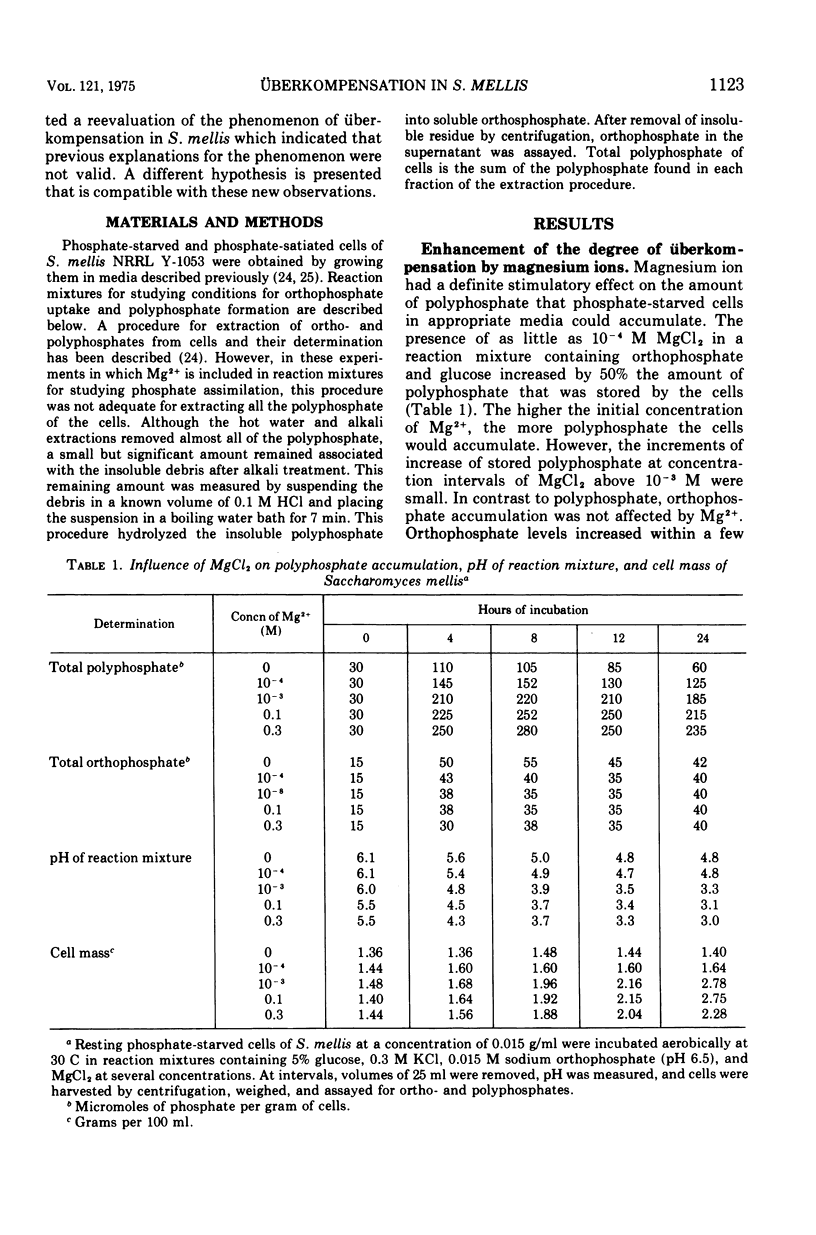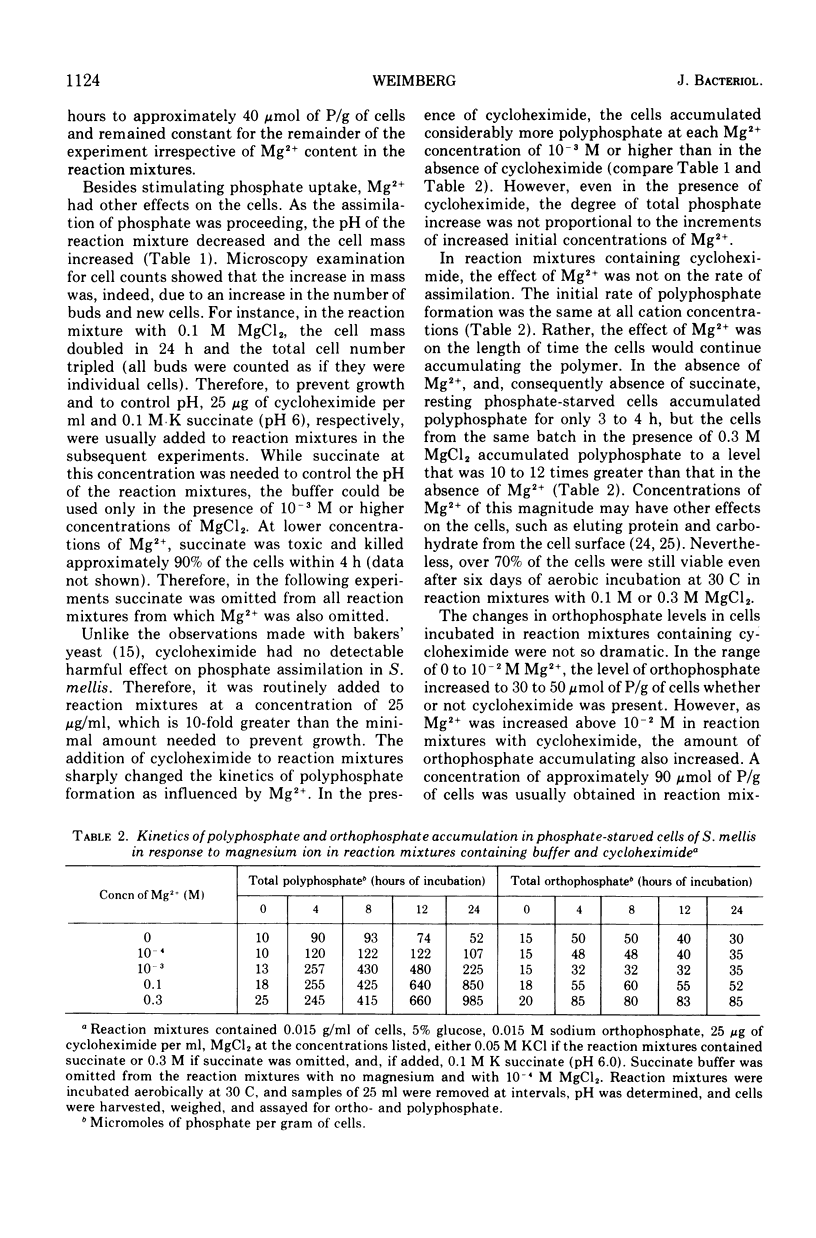Abstract
Magnesium ion enhances the maximum amount of polyphosphate that resting phosphate-starved cells of Saccharomyces mellis can store by increasing the length of time the cells will continue assimilating phosphate. The divalent cation has no effect on the rate of formation of polymer. As much as 12 times more polyphosphate is formed in cells incubated in reaction mixtures containing 0.3 M MgCl2 than in the absence of Mg2+. Potassium ion also has an influence on the amount of polyphosphate that phosphate-starved cells can accumulate but the degree of stimulation is not very large. Mg2+ and K+ have no effect on polyphosphate formation or storage in phosphate-satiated cells. Apparently, then, there are two systems for polyphosphate accumulation in S. mellis. Each system is stable in nondividing cells. The one present in phosphate-starved cells seems to be repressible by growth of the organism in media containing orthophosphate. The shift from the derepressed state to the repressed state, or vice versa, occurs only in exponentially dividing cells in appropriate media with 100% of the cells in the new physiological state by the time the cell mass has doubled. It is suggested that the word to describe the phenomenon of the accumulation of higher amounts of polyphosphate in phosphate-starved cells than the steady-state level of phosphate-satiated cells be changed from "uberkompensation" to "magnesium ubertriebung," or "magnesium enhancement."
Full text
PDF








Selected References
These references are in PubMed. This may not be the complete list of references from this article.
- Blum J. J. Phosphate uptake by phosphate-starved Euglena. J Gen Physiol. 1966 Jul;49(6):1125–1137. doi: 10.1085/jgp.0491125. [DOI] [PMC free article] [PubMed] [Google Scholar]
- GOODMAN J., ROTHSTEIN A. The active transport of phosphate into the yeast cell. J Gen Physiol. 1957 Jul 20;40(6):915–923. doi: 10.1085/jgp.40.6.915. [DOI] [PMC free article] [PubMed] [Google Scholar]
- Harold F. M. Inorganic polyphosphates in biology: structure, metabolism, and function. Bacteriol Rev. 1966 Dec;30(4):772–794. doi: 10.1128/br.30.4.772-794.1966. [DOI] [PMC free article] [PubMed] [Google Scholar]
- Indge K. J. Polyphosphates of the yeast cell vacuole. J Gen Microbiol. 1968 May;51(3):447–455. doi: 10.1099/00221287-51-3-447. [DOI] [PubMed] [Google Scholar]
- Jungnickel F. Vergleich des Einflusses der Veratmung endogener und exogener Substrate auf Polyphosphatbildung und Kaliumaufnahme bei phosphatverarmten Zellen von Candida utilis. Arch Mikrobiol. 1966 Nov 11;55(2):175–186. [PubMed] [Google Scholar]
- LISS E., LANGEN P. [Experiments on polyphosphate overcompensation in yeast cells after phosphate deficiency]. Arch Mikrobiol. 1962;41:383–392. [PubMed] [Google Scholar]
- MIYACHI S., KANAI R., MIHARA S., MIYACHI S., AOKI S. METABOLIC ROLES OF INORGANIC POLYPHOSPHATES IN CHLORELLA CELLS. Biochim Biophys Acta. 1964 Dec 9;93:625–634. doi: 10.1016/0304-4165(64)90345-9. [DOI] [PubMed] [Google Scholar]
- Munk N., Rosenberg H. On the deposition and utilization of inorganic pyrophosphate in Tetrahymena pyriformis. Biochim Biophys Acta. 1969 May 6;177(3):629–640. doi: 10.1016/0304-4165(69)90329-8. [DOI] [PubMed] [Google Scholar]
- Niemeyer R., Richter G. Schnellmarkierte Polyphosphate und Metaphosphate bei der Glaualge Anacystis niculans. Arch Mikrobiol. 1969;69(1):54–59. [PubMed] [Google Scholar]
- Nordheim W., Redinger L., Müller G. Die Regulation des Energiestoffwechsels von Candida utilis durch den Phosphat-gekoppelten magensium-transfer in die Zelle. Enzymologia. 1967 Mar 31;32(3):189–197. [PubMed] [Google Scholar]
- ROTHSTEIN A., HAYES A., JENNINGS D., HOOPER D. The active transport of Mg++ and Mn++ into the yeast cell. J Gen Physiol. 1958 Jan 20;41(3):585–594. doi: 10.1085/jgp.41.3.585. [DOI] [PMC free article] [PubMed] [Google Scholar]
- Reilly C., Fuhrmann G. F., Rethstein A. The inhibition of K + and phosphate uptake in yeast by cycloheximide. Biochim Biophys Acta. 1970 Jun 2;203(3):583–585. doi: 10.1016/0005-2736(70)90197-5. [DOI] [PubMed] [Google Scholar]
- Rosenberg H., Munk N. Transport phenomena associated with the deposition and disappearance of pyrophosphate granules in Tetrahymena pyriformis. Biochim Biophys Acta. 1969 Jun 17;184(1):191–197. doi: 10.1016/0304-4165(69)90114-7. [DOI] [PubMed] [Google Scholar]
- Souzu H. Decomposition of polyphosphate in yeast cell by freeze-thawing. Arch Biochem Biophys. 1967 May;120(2):338–343. doi: 10.1016/0003-9861(67)90248-2. [DOI] [PubMed] [Google Scholar]
- Souzu H. Location of polyphosphate and polyphosphatase in yeast cells and damage to the protoplasmic membrane of the cell by freeze-thawing. Arch Biochem Biophys. 1967 May;120(2):344–351. doi: 10.1016/0003-9861(67)90249-4. [DOI] [PubMed] [Google Scholar]
- TAUSSKY H. H., SHORR E. A microcolorimetric method for the determination of inorganic phosphorus. J Biol Chem. 1953 Jun;202(2):675–685. [PubMed] [Google Scholar]
- Terry K. R., Hooper A. B. Polyphosphate and orthophosphate content of Nitrosomonas europaea as a function of growth. J Bacteriol. 1970 Jul;103(1):199–206. doi: 10.1128/jb.103.1.199-206.1970. [DOI] [PMC free article] [PubMed] [Google Scholar]
- VAN STEVENINCK, BOOIJ H. L. THE ROLE OF POLYPHOSPHATES IN THE TRANSPORT MECHANISM OF GLUCOSE IN YEAST CELLS. J Gen Physiol. 1964 Sep;48:43–60. doi: 10.1085/jgp.48.1.43. [DOI] [PMC free article] [PubMed] [Google Scholar]
- WEIMBERG R., ORTON W. L. REPRESSIBLE ACID PHOSPHOMONOESTERASE AND CONSTITUTIVE PYROPHOSPHATASE OF SACCHAROMYCES MELLIS. J Bacteriol. 1963 Oct;86:805–813. doi: 10.1128/jb.86.4.805-813.1963. [DOI] [PMC free article] [PubMed] [Google Scholar]
- WEIMBERG R., ORTON W. L. SYNTHESIS AND BREAKDOWN OF THE POLYPHOSPHATE FRACTION AND ACID PHOSPHOMONOESTERASE OF SACCHAROMYCES MELLIS AND THEIR LOCATIONS IN THE CELL. J Bacteriol. 1965 Mar;89:740–747. doi: 10.1128/jb.89.3.740-747.1965. [DOI] [PMC free article] [PubMed] [Google Scholar]
- Weimberg R. Effect of potassium chloride on the uptake and storage of phosphate by Saccharomyces mellis. J Bacteriol. 1970 Jul;103(1):37–48. doi: 10.1128/jb.103.1.37-48.1970. [DOI] [PMC free article] [PubMed] [Google Scholar]


